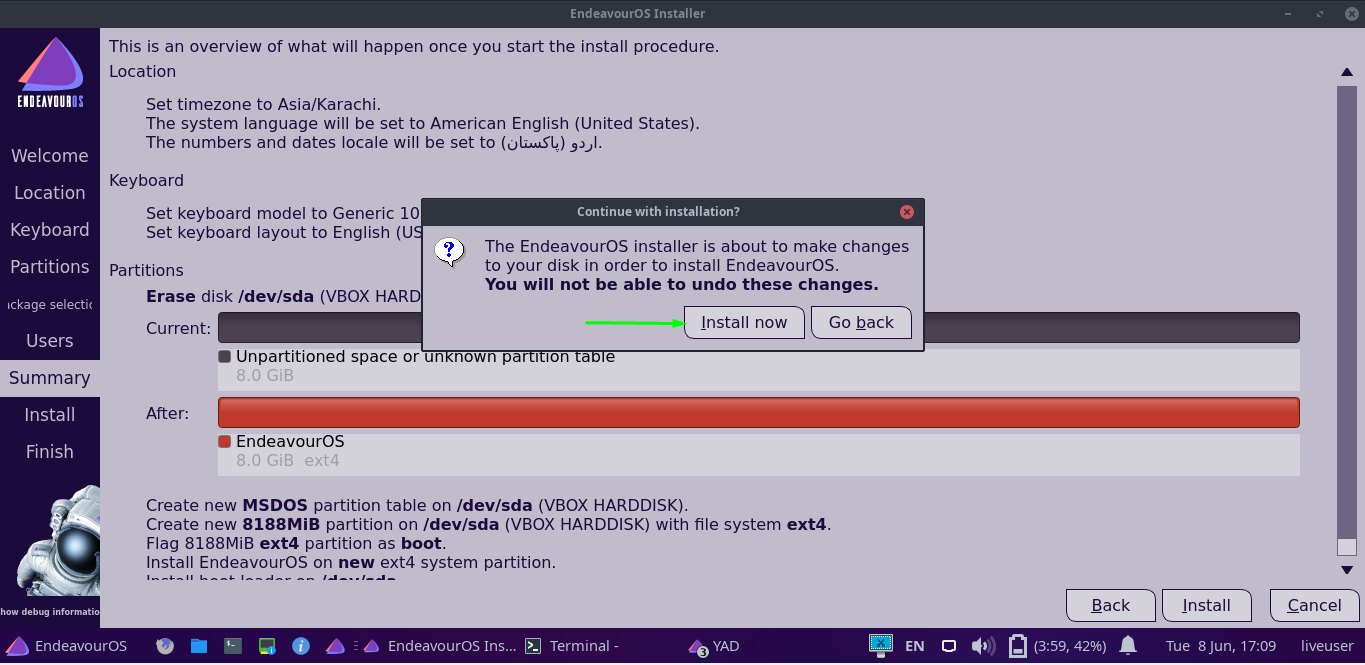
Endeavouros install#
Sudo pacman -S -needed bluez bluez-utils pulseaudio-bluetoothĪnd install graphical GUI tools to configure and manage Bluetooth:īlueman (gtk) recommended for GTK based īluedevil (qt) ĭEs like KDE/plasma and GNOME ship their own Bluetooth GUI by default.
Endeavouros manual#
If you are using pulseaudio (older installs or manual switching to pulseaudio): If you are using pipewire (default since Atlantis release): In case you want to make sure all packages are still installed or you may remove some, using custom install e.t.c. With this, you can handle Bluetooth devices over CLI tool bluetoothctl most Desktops will have some setup in there setting tools, if not see at the bottom about And install graphical GUI tools to configure and manage Bluetooth. Sudo systemctl enable bluetooth # to enable per default, will run after every boot. Sudo systemctl start bluetooth # to start it for the session will stay disabled after reboot. To be able to use Bluetooth you need to start the service or enable it if you need Bluetooth running on every boot: Needed packages are installed by default, but it is in their default disabled state.
Endeavouros how to#
You can see how to install them on their respective sites.We do not enable Bluetooth by default, because of several security risks, and to prevent unneeded power consumption. Go to Keyboard → Keyboard Shortcuts → View and Customize Shortcuts → Navigation → Switch to Workspace #Īpart from the GUI goodness, I also use Oh My Zsh for my Zsh shell and Oh My Posh for Bash. In Gnome, this can be done by opening the settings app and doing the following: I usually use Alt+1, Alt+2, Alt+3, and Alt+4 to switch to the Workspace 1, 2, 3, and 4, respectively. I like to assign hotkeys for workspace navigation. If you are using Gnome, you can also try to add the printer through Gnome’s printer selection in its settings. I am using a Canon E410 printer, and in the event that the printer is not detected right away by the OS, we can use the CUPS configuration tool (accessible at localhost:631) to configure the printing server. Since Arch Linux-based distros can use AUR, many packages which are provided independently and do not have an official repository can be updated with the yay command. It has an application helper which is most useful for newbies, but could also be useful for seasoned Linux users who might have missed the boat for new applications. Support for printing is quite easy to set up. If you want to install it for the first time, just type yay -S ksshaskpass. Since I already installed ksshaskpass, we can see that the status is indicated as “Installed”. Ssh-add helper that uses kwallet and kpassworddialog Ssh-add helper that uses kwallet-git and kpassworddialogĮxtra/ksshaskpass 5.27.3-1 (29.7 KiB 101.9 KiB) (Installed) If you want Bluetooth and cron jobs to start automatically, first check whether they are running with:Īur/ksshaskpass-git 5.22.80_r196.gdaa2679-1 (+6 0.00) After checking online, I found that I have to enable the cronie service first.īluetooth is another service that isn’t running by default. One thing that I noticed is that by default the cron service is not enabled.

(Any distro using the Calamares installer tool will also have this feature.)Īfter the basic installation, I usually need to do some other customizations before it’s suitable for daily usage. The Linux Unified Key Setup (LUKS) encryption option is available during the installation process.

The most notable differences between EndeavourOS and Arch Linux are EndeavourOS’s GUI-based installer-we can select between installing XFCE, Plasma KDE, Gnome, and several others desktop environments-as well as wallpapers and some other tools, for instance, EndeavourOS QuickStart Installer and EndeavourOS log tools.Īlso, EndeavourOS notifies the user when there are pending OS updates, making it easy to keep my box up to date, especially when I am busy during the week and forget to apply important OS updates! InstallationĮndeavourOS is quite easy to install. It supports the features that I need: It has a strong community and most of Arch Linux’s documentation/references are still applicable to it, like they are to most Arch Linux-based distros using systemd. For example, I am a Gnome desktop user, so I don’t want to install the game packages I won’t use. If possible, the distro of choice should be able to trim down the number of default packages.Has a Linux Unified Key Setup (LUKS) full-disk encryption option in the installation.



 0 kommentar(er)
0 kommentar(er)
